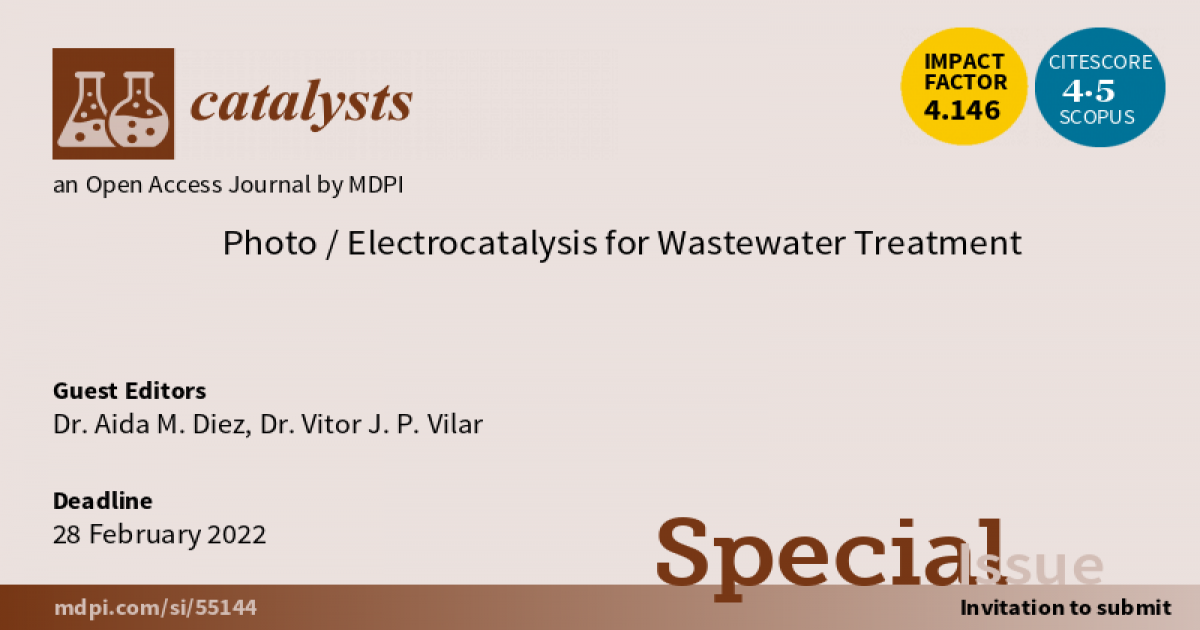Photo/Electrocatalysis for Wastewater Treatment
A special issue of Catalysts (ISSN 2073-4344). This special issue belongs to the section "Photocatalysis".
Deadline for manuscript submissions: closed (10 July 2022) | Viewed by 41846

Special Issue Editors
Interests: Advanced Oxidation Processes combination for organic pollutants abatement; real wastewaters treatment; reactor set-up for performance enhancement; synthesis of new photocatalyst based on TiO2; adsorption with inexpensive materials and their regeneration process; photocatalytic plastic degradation; water splitting and CO2 photo-reduction
Interests: environmental assessment and monitoring of surface waters; environmental friendly technologies for pollution control; advanced oxidation processes; electrochemical advanced oxidation processes, ozonation, membrane filtration, sorption/biosorption, biological degradation, process integration and intensification; water/waste reuse, recycling and valorisation
Special Issues, Collections and Topics in MDPI journals
Special Issue Information
Dear Researchers,
A wide array of wastewater treatment alternatives are being investigated nowadays, which is in harmony with the increase in polluted wastewater generation due to the growth in population and industrial activities.
Advanced oxidation processes (AOPs) have become in the last few years a selected alternative due to several advantages, such as their non-selective degradation of pollutants and their easy setup. Photo-based processes have always been one of the most preferred AOP options, due to the possibility of using solar radiation which may reduce the AOPs’ high elevated costs.
Nevertheless, photolysis is usually inefficient for pollutant degradation, due to the lack of radiation adsorption of the vast majority of compounds, and even in the case when pollutant is photo-active, the degradation rates are usually slow. Thus, the utilization of photocatalysis has risen lately. Thus, the photocatalyst is activated with radiation, which brings about the separation of electrons and holes from, respectively, the valence and conduction bands of semiconductor photocatalysts, starting a series of chain reactions which leads to the generation of oxidants and, ultimately, to pollutant degradation.
However, even photocatalysis has limitations for future applications; for instance, the electrons and holes are usually recombined, long treatment times are required, etc. As a solution, the combination of photocatalysis with the application of an electrochemical field (photoelectrocatalysis) has been contemplated.
This Special Issue is focused on the application of photoelectrocatalysis for the treatment of different wastewaters. Thus, recent research focused on photoelectrocatalysis which somehow enhances previous studies for the degradation of pollutants and which contributes to the future application of this technology is welcome to form part of this Special Issue. For instance, the submission of manuscripts related to the synthesis of new photocatalysts which defeat the performance of the typical TiO2, the set-up of new reactor configurations, the modification of the electrodes to ensure long and efficacious treatments, the evaluation of the process with real wastewaters, the scale-up of the process, etc. is encouraged.
Dr. Aida M. Diez
Dr. Vitor J. P. Vilar
Guest Editors
Manuscript Submission Information
Manuscripts should be submitted online at www.mdpi.com by registering and logging in to this website. Once you are registered, click here to go to the submission form. Manuscripts can be submitted until the deadline. All submissions that pass pre-check are peer-reviewed. Accepted papers will be published continuously in the journal (as soon as accepted) and will be listed together on the special issue website. Research articles, review articles as well as short communications are invited. For planned papers, a title and short abstract (about 100 words) can be sent to the Editorial Office for announcement on this website.
Submitted manuscripts should not have been published previously, nor be under consideration for publication elsewhere (except conference proceedings papers). All manuscripts are thoroughly refereed through a single-blind peer-review process. A guide for authors and other relevant information for submission of manuscripts is available on the Instructions for Authors page. Catalysts is an international peer-reviewed open access monthly journal published by MDPI.
Please visit the Instructions for Authors page before submitting a manuscript. The Article Processing Charge (APC) for publication in this open access journal is 2200 CHF (Swiss Francs). Submitted papers should be well formatted and use good English. Authors may use MDPI's English editing service prior to publication or during author revisions.
Keywords
- Wastewater pollutant degradation
- Photocatalysis coupled to electrolysis
- Catalysts synthesis
- Electrodes characterization
- Advanced Oxidation Processes
- Reactor set-up
- Real applications
Benefits of Publishing in a Special Issue
- Ease of navigation: Grouping papers by topic helps scholars navigate broad scope journals more efficiently.
- Greater discoverability: Special Issues support the reach and impact of scientific research. Articles in Special Issues are more discoverable and cited more frequently.
- Expansion of research network: Special Issues facilitate connections among authors, fostering scientific collaborations.
- External promotion: Articles in Special Issues are often promoted through the journal's social media, increasing their visibility.
- e-Book format: Special Issues with more than 10 articles can be published as dedicated e-books, ensuring wide and rapid dissemination.
Further information on MDPI's Special Issue polices can be found here.






